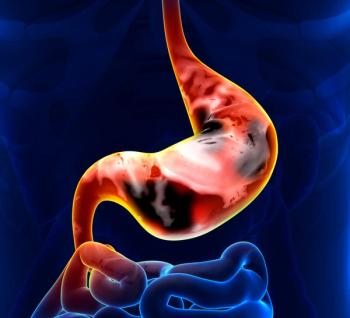
Ibrutinib/Venetoclax Yields Durable Benefit in Previously Untreated CLL
Ibrutinib and venetoclax may prove beneficial in previously untreated chronic lymphocytic leukemia.
The combination of ibrutinib (Imbruvica) and venetoclax (Venclexta) provided durable complete responses (CRs) in patients with previously untreated chronic lymphocytic leukemia (CLL), even in high-risk subgroups, according to the results of a phase 2 study (NCT02756897) published in JAMA Oncology.1
Results from the trial indicated that 75% of the patients who were treated with the combination achieved bone marrow undetectable measurable residual disease (MRD) as a best response at any time throughout the trial. Moreover, at 12 cycles of therapy, 56% of patients achieved bone marrow undetectable MRD remission. Twenty-four percent of patients also had a low MRD-positive response, 6% had a high MRD-positive response, and 14% discontinued treatment prior to the assessment at cycle 12. After 24 cycles of therapy, 66% of the population had achieved bone marrow undetectable MRD remission, 16% experienced a low MRD-positive response, 1% had a high MRD-positive response, and 16% had discontinued treatment prior to the cycle 24 assessment.
After 12 cycles of receiving the combination therapy, 69% of patients achieved a CR or a CR with incomplete count recovery (CRi) and 13% achieved a partial response. In total 78% of patients who received the combination had a CR/CRi as a best response.
Due to synergy observed in preclinical trials, complementary therapeutic activity, and non-overlapping safety profiles that have been previous identified for the combination of ibrutinib and venetoclax, investigators sought to assess the combination in treatment-naïve patients with CLL.2,3
Patients who enrolled on the study were required to have del(17p), a TP53 mutation, del(11q), unmutated immunoglobulin heavy-chain variable gene, and/or be 65 years or older.
Single-agent ibrutinib was administered at 420 mg per day for the first 3 cycles. This was followed by the addition of a standard dose ramp-up of venetoclax, which started at 20 mg per day and escalated to a target of 400 mg per day. The combination was administered for 24 planned cycles that were 28 days each. Those who maintained MRD positivity by the end of the 24 cycles of combination therapy were able to continue undergoing treatment with single-agent ibrutinib. The trial protocol was also amended to allow patients to receive an additional 12 cycles of combination therapy.
The primary end point of the trial was best response achieved at any time during treatment and up to 2 months following completion of treatment with ibrutinib and venetoclax. Time-to-event outcomes included progression-free survival (PFS) and overall survival (OS).
In total, 80 patients—consisting of 23 women and 57 men—initiated treatment with the combination between August 2016 and June 2018. Patients had a median age of 65 years. Moreover, 18% of patients had del(17p), 14% had a TP53 mutation, and 23% had del(17p) and/or TP53-mutant disease.
Among those who enrolled, 5 patients discontinued treatment with single-agent ibrutinib for reasons beyond disease progression. The median follow-up for all 80 patients was 38.5 months (range, 5.6-51.1 months).
Additional findings indicated that patients who achieved a bone marrow MRD of less than 1% at the first response assessment following treatment with the combination therapy were more likely to achieve undetectable MRD remission by the completion of cycle 12 (77% vs 20%; P <.001). Additionally, those who achieved a 2-log reduction in bone marrow by the end of cycle 3 were more likely to achieve bone marrow undetectable MRD remission by cycle 12 (83% vs 20%; P <.001).
Investigators also reported an estimated 3-year PFS rate of 93% (95% CI, 88%-99%) and estimated 3-year OS rate of 96% (95% CI, 92%-100%). Additionally, patients with del(17p)/TP53-mutant disease had an estimated 3-year PFS of 86%. No patients experienced disease progression. Although 2 patients developed diffuse large B-cell lymphoma with Richter transformation, both patients continue to be alive and in remission following allogenic stem cell transplant.
In total, 2 patients discontinued treatment during cycle 1 of ibrutinib monotherapy and an additional 6 patients died 27 months later due to infection. Notably, 1 patient died while in bone marrow undetectable MRD remission during cycle 19 of combination therapy. The death was due to pneumonia, which was possibly related to treatment with ibrutinib.
In terms of safety, 51% of patients experienced grade 3/4 neutropenia, and grade 3 thrombocytopenia occurred in 2% of patients. Four patients experienced neutropenic fever and non-hematologic adverse effects were experienced by 5% of patients. Hospitalizations occurred in patients who developed pneumonia (n = 5), cellulitis (n = 3), non-neutropenic fever (n = 1), anaplasmosis infections (n = 1), septic arthritis (n = 1), disseminated cryptococcal infection (n = 1), aspergillus/cryptococcal infection (n = 1), and appendicitis/cholecystitis (n = 1).
The combination was recently examined as a first-line option for patients with CLL and small lymphocytic leukemia in the
References
- Jian N, Keating M, Thompson P, et al. Ibrutinib plus venetoclax for first-line treatment of chronic lymphocytic leukemia a nonrandomized phase 2 trial. JAMA Oncol. Published online June 10, 2021. doi:10.1001/jamaoncol.2021.1649
- Cervantes-Gomez F, Lamothe B, Woyach JA, et al. Pharmacological and protein profiling suggests venetoclax (ABT-199) as optimal partner with ibrutinib in chronic lymphocytic leukemia. Clin Cancer Res. 2015;21(16):3705-3715. doi:10.1158/1078-0432.CCR-14-2809
- Jain N, Keating M, Thompson P, et al. Ibrutinib and venetoclax for first-line treatment of CLL. N Engl J Med. 2019;380(22):2095-2103. doi:10.1056/NEJMoa1900574
- Ghia P, Allan JN, Siddiqi T, et al. Fixed-duration (FD) first-line treatment (tx) with ibrutinib (I) plus venetoclax (V) for chronic lymphocytic leukemia (CLL)/small lymphocytic lymphoma (SLL): primary analysis of the FD cohort of the phase 2 captivate study. J Clin Oncol. 2021;39(suppl 15):7502. doi:10.1200/JCO.2021.39.15_suppl.7502
Newsletter
Stay up to date on recent advances in the multidisciplinary approach to cancer.


















































































